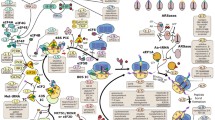Abstract
The effect of the novel aromatic bisamidine 1 on protein synthesis in cell-free translational system isolated from rat livers was studied. The bisamidine 1 caused inhibition of [14C]leucine incorporation into proteins proportionally to its concentration. To establish a precise mechanism of inhibition, we evaluated the effect of the bisamidine 1 on the isolated ribosomes and purified to homogeneity elongation factors. Preincubation of the bisamidine 1 with ribosomes resulted in partial inhibition of their activity in whole elongation system. The eucaryotic elongation factor 1 (eEF-1) was not significantly affected by the bisamidine 1. In contrast to eEF-1, the bisamidine 1 preincubated with the eucaryotic elongation factor 2 (eEF-2) caused total inhibition of its activity in the translocation process. The inhibitory effect of the bisamidine 1 on eEF-2 activity was confirmed in diphtheria toxin-dependent ADP-ribosylation reaction. The results suggest a high action specificity of the bisamidine 1 as potential anticancer drug, since the primary target seems to be highly conserved protein-elongation factor 2.
Similar content being viewed by others
References
Bailly Ch, Dassonneville L, Carrasco C, Lucas D, Kumar A, Boykin DW, Wilson WD: Relationships between topoisomerase II inhibition, sequence-specificity and DNA binding mode of dicationic diphenylfuran derivatives. Anti-Cancer Drug Des 14: 47–60, 1999
Denny WA: New direction in the design of anticancer drugs. Drug Des Delivery 3: 99–124, 1988
Boykin DW, Kumar A, Spychala J, Zhou M, Lombardy RJ, Wilson WD, Dykstra ChC, Jones SK, Hall JE, Tidwell RR, Laughton Ch, Nunn ChM, Neidle S: Dicationic diarylfurans as anti-Pneumocystis carinii agents. J Med Chem 38: 912–916, 1995
Gambari R, Nastruzzi C: DNA-binding activity and biological effects of aromatic polyamides. Biochem Pharmacol 47: 599–610, 1994
Chiang SAY, Welch J, Rauscher FJ, Beerman TA: Effects of minor groove binding drugs on the interaction of TATA box binding protein and TFIIA with DNA. Biochemistry 33: 7033–7040, 1994
Bailly Ch, Chaires JB: Sequence-specific DNA minor groove binders. Design and synthesis of netropsin and distamycin analogues. Bioconjugate Chem 9: 513–538, 1998
Neidle S, Kelland LR, Trent JO, Simpson IJ, Boykin DW, Kumar A, Wilson WD: Cytotoxicity of bis(phenylamidinium)furan alkyl derivatives in human tumour cell lines: Relation to DNA minor groove binding. Bioorg Med Chem Lett 11: 1403–1408, 1997
Moldave K: Eukaryotic protein synthesis. Annu Rev Biochem 54: 1109–1149, 1985
Riis B, Rattan SIS, Clark BFC, Merrick WC: Eukaryotic protein elongation factors. Trends Biochem Sci 15: 420–424, 1990
Gajko A, Galasinski W, Gindzienski A: Purification and characterization of the protein kinase eEF-2 isolated from rat liver cells. Acta Biochim Polon 41: 421–427, 1994
Nygard O, Nilsson A, Carlberg U, Nilsson L, Amons R: Phosphorylation regulates the activity of the eEF-2 specific Ca2+ and calmodulin-dependent protein kinase III. J Biol Chem 266: 16425–16430, 1991
Lee H, Iglewski WJ: Cellular ADP-ribosyltransferase with the same mechanism of action as diphtheria toxin and Pseudomonas toxin A. Proc Natl Acad Sci USA 81: 2703–2707, 1984
Iglewski BH, Liu P, Kabat D: Mechanism of action of Pseudomonas aeruginosa exotoxin A: Adenosine diphosphate-ribosylation of mammalian elongation factor 2 in vitro and in vivo. Infect Immun 15: 138–144, 1997
Bielawski K, Galicka A, Bielawska A, Sredzinska K: Inhibitory effects of pentamidine analogues on protein biosynthesis in vitro. Acta Biochim Polon 47: 113–120, 2000
Skogerson L, Moldave K: The binding of aminoacyl transferase II to ribosomes. Biochem Biophys Res Commun 27: 568–572, 1967
Galasinski W, Moldave K: Purification of aminoacyltransferase II (translocation factor) from rat liver. J Biol Chem 244: 6527–6532, 1969
Moldave K: The preparation of 14C-amino acyl soluble-tRNA. Meth Enzymol 6: 757–761, 1963
Gajko A, Galasinski W, Gindzienski A: Multiformity of elongation factor eEF-2 isolated from rat liver cells. Biochem Biophys Res Commun 202: 844–849, 1994
Laemmli UK: Cleavage of structural proteins during the assembly of the head of bacteriophage T4. Nature (Lond.) 227: 680–685, 1970
Riis B, Rattan SIS, Clark BFC: Estimating the amounts of ADPribosylatable active elongation factor-2 in mammalian cell-free extracts. J Biochem Biophys Meth 19: 319–326, 1989
Laskey RA, Mills AD: Quantitative film detection of 3H and 14C in polyacrylamide gels by fluorography. Eur J Biochem 56: 335–341, 1975
Gajko A, Sredzinska K, Galasinski W, Gindzienski A: Possibility of the transformation of eEF-2 (100 kDa) to eEF-2 (65 kDa) in the peptide elongation process in vitro. Biochem Biophys Res Commun 255: 535–538, 1999
Galicka A, Sredzinska K, Gindzienski A: Cytoplasmic inhibitor of eEF-2 ADP-ribosylation catalyzed by diphtheria toxin or endogenous transferase in rat liver cells. Biochem Biophys Res Commun 269: 553–556, 2000
Nilsson L, Nygard O: Localization of the sites of ADP-ribosylation and GTP binding in the eukaryotic elongation factor EF-2. Eur J Biochem 148: 299–304, 1985
Nygard O, Nilsson L: Characterization of the ribosomal properties required for formation of a GTPase active complex with the eukaryotic elongation factor 2. Eur J Biochem 179: 603–608, 1989
Rights and permissions
About this article
Cite this article
Gajko-Galicka, A., Bielawski, K., Sredzinska, K. et al. Elongation factor 2 as a target for selective inhibition of protein synthesis in vitro by the novel aromatic biasamidine. Mol Cell Biochem 233, 159–164 (2002). https://doi.org/10.1023/A:1015548131930
Issue Date:
DOI: https://doi.org/10.1023/A:1015548131930




